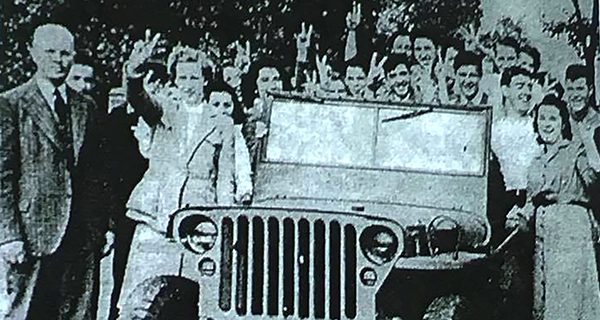[ccfic caption-text format="plaintext"]
By Katrina Margolis
Hometown Weekly Reporter
Today, Jeeps are ubiquitous. Driven by everyone from newly minted 16-year-old girls to veteran drivers of forty years. However, when John Simeone saw a Jeep on the streets of Walpole in 1943, he was absolutely dumbfounded. What was an army vehicle doing rolling down suburban streets? He said he waved and waved, trying to get the driver’s attention, enthralled by the very sight of a Jeep in that context.
Simeone is a World War II re-enactor, and owner of his own vintage Jeep. Over the course of two hours, he relayed extensively the history of the Jeep, a car originally created as a lightweight, four-wheel drive reconnaissance car. However, Jeep was a term that wasn’t used officially for years. In fact, the term Jeep comes originally from a Popeye comic. Popeye the Sailor had a pet who was incredibly loyal and all he could say was, “Jeep! Jeep!” As these new cars began to actually be present in battle, the platoons began to call them Jeeps, as they were incredibly loyal and could disappear into the forest due to their color, much as Popeye’s friend did.
Ultimately made by Willys, there was a battle over who would get the commission between Ford, Bantam and Willys. Willys got the commission and the license, and so while Ford was also commissioned to create a huge number of these vehicles, they were all under Willys license. The main thing was standardization. The Germans had some of the most complicated and advanced machinery in the world, however a mechanic who could work on one vehicle couldn’t necessarily work on another. These Jeeps, no matter who made them, all had interchangeable parts, and so anyone who knew the Jeep could work on any individual car.
Simeone’s own Jeep was built by Willys, but has one piece with a distinct script ‘F’ printed on it. While the government didn’t allow Willys or Ford to put their names on the vehicle directly, Ford printed an F on every piece it manufactured, so that their handiwork could be seen. It also shows the interchangeability of these vehicles, since Simeone’s own Jeep is a combination of the two companies’ pieces.
Simeone guessed that the Jeeps in Walpole must have been headed to a local school, where children were encouraged to raise money in the form of buying and selling war bonds in order to send a Jeep to the troops. Walpole High School was able to raise enough money to send two Jeeps, and a plaque with WHS was placed on the front to identify those from the rest.
After the war, Willys began to manufacture CJs, or civilian Jeeps, which have become the cars that we all know and recognize today. Seemingly from a different world, these cars are in fact relics of an earlier age in American history.






















